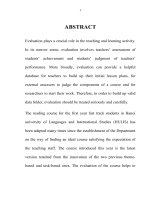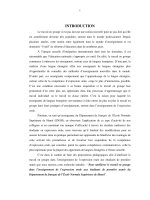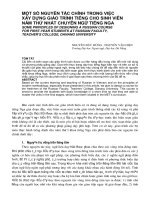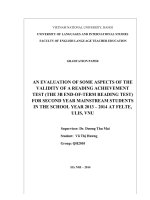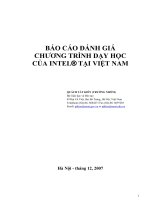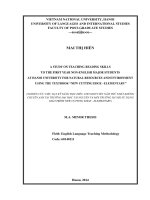ĐÁNH GIÁ CHƯƠNG TRÌNH dạy đọc 1 CHO SINH VIÊN năm THỨ NHẤT hệ CHẤT LƯỢNG CAO KHOA NN&VH ANH mỹ ĐHNN ĐHQGHN
Bạn đang xem bản rút gọn của tài liệu. Xem và tải ngay bản đầy đủ của tài liệu tại đây (185.06 KB, 31 trang )
1
ABSTRACT
Evaluation plays a crucial role in the teaching and learning activity.
In its narrow sense, evaluation involves teachers’ assessment of
students’ achievement and students’ judgment of teachers’
performance. More broadly, evaluation can provide a helpful
database for teachers to build up their initial lesson plans, for
external assessors to judge the components of a course and for
researchers to start their work. Therefore, in order to build up valid
data folder, evaluation should be treated seriously and carefully.
The reading course for the first year fast track students in Hanoi
university of Languages and International Studies (HULIS) has
been adapted many times since the establishment of the Department
on the way of finding an ideal course satisfying the expectation of
the teaching staff. The course introduced this year is the latest
version resulted from the innovation of the two previous theme-
based and task-based ones. The evaluation of the course helps to
2
identify the strength and the weakness of the course, contributing to
the staff’s decision-making about the ideal one.
It is in this view that the study seeks to evaluate the reading course 1
for the first year fast track students at HULIS. Specifically, it
involves the evaluation of the course syllabus and the course
material with a view to confirming the potency of the course as well
as proposing implications to innovate the course. Hopefully, the
innovation would bring the course closer to the ideal one expected
by the teaching staff of the Department.
3
ACKNOWLEDGEMENTS
First of all, I owe my indebtedness to my supervisor Ms. Phung Ha
Thanh, MA for her valuable guidance throughout the process of this
research.
I would like to express my sincere thanks to the teaching staff of the Fast
track program, especially to Ms. Nguyen Thu Trang for their providing
me with related documents and suggestions for my research, without
which the project would not have been accomplished.
A special thank would also go to the two groups of first year fast track
students who took part in the lessons, contributed to the idea budget and
spent time completing my questionnaires. The information collected was
a precious source of data to make the research fruitful.
Lastly, I would like to express my gratitude to my family for their
support and encouragements from the beginning to the end of the
research process.
4
PART 1. INTRODUCTION
Evaluation is especially important in education, or more
specifically, in the teaching and learning of a language. At the
outset, the evaluating process helps teachers and students determine
learning achievements or satisfaction. Later on, the evaluation
outcomes offer a good data base for novice teachers to develop
initial lesson plans and teaching practice, and for interested teachers
to conduct further research and improvement. (Kiely and Rea-
Dickins, 2005, p. 5).
For this reason, evaluation must be done in a well-planned valid
way. For example, in order to judge the value of a language course
or program, the evaluation must “include all the practices and
instruments involved in gathering and compiling the data necessary
to make judgments” about it (Brown and Rodgers, 2005, p. 227).
Teachers may do evaluation to check the effectiveness of the course
materials, of the classroom activities, of the students’ learning or
5
such (Brown and Rodgers, 2005, p. 228). Only by doing this would
the evaluation “confirm the validity of the classroom practice” when
any partial elements of the course are satisfactory and “form a
basis” for changes when they are not (Germaine et al., 1992).
Knowing the importance of course evaluation, the current research
was conducted to evaluate Reading course 1 – the first reading
course for first year students in the fast-track program, University of
languages and International Studies. The evaluation based itself on
the following context.
Reading, in the belief shared among the teaching staff of the fast
track program, is of great importance to Fast-track students. In the
era of informatization when knowledge has a short life, students
need to read well to form a good basis for their self-study as well as
for their study in class. Therefore, since its establishment in 2001,
the fast track teaching group has piloted many versions of reading
course for their freshmen. A skill-based reading course applied in
the beginning years succeeded in providing students with sufficient
6
reading sub-skills to develop reading on their own, yet at the same
time it failed to boost their background knowledge. A theme-based
reading course that followed produced students with a good
vocabulary pool but without an adequate understanding of the
reading strategies to become critical readers. All the preceding
versions of the reading course showed their deficiencies, which
urges the staff to come up with a new one capable of combining the
advantages of its elder brothers and efficiently dealing with their
disadvantages.
Reading course 1 is the newest version resulted from the piloting of
different types of prior versions. The course is the meeting point of
a skill-based approach and a theme-based one. Whether this would
be the ideal course in demand to be continued in the following years
is open to question. An evaluation of the course is, therefore, called
for as a “means analysis” to gain information for the answer
(Germaine et al., 1992).
7
The research aims at analyzing and evaluating the reading course
for first-year fast track students. Specifically, it consists of an
evaluation of the syllabus and the material.
Hopefully, the research would find answers to the following
questions:
In terms of the satisfaction of students’ needs:
• To what extent does the course meet students’ need in terms of
language providing and skills developing, from the
perspective of the students?
• To what extent does the course meet students’ need in terms of
language providing and skills developing, from the
perspective of the teacher?
In terms of achievements of objectives:
• To what extent does the course satisfy all the objectives set by
the teaching staff of the Fast-track Program, from the
perspective of the students?
8
• To what extent does the course satisfy all the objectives set by
the teaching staff of the Fast-track Program, from the
perspective of the teacher?
In terms of facilities:
• How well are the facilities utilized in helping the students in
the learning activities, from the perspective of the students?
• How well are the facilities utilized in helping the teacher in
the teaching activities, from the perspective of the teacher?
In terms of course assignments:
• How effective are the assignments in helping the students
achieve their goals, from the perspective of the students?
• How effective are the assignments in checking students’
progress, from the perspective of the teacher?
In terms of course book:
• How suitable is the course book to the learners’ level, from
the perspective of the students?
9
• How suitable is the course book to the learners’ level, from
the perspective of the teacher?
• How effective is the course book in helping the students
achieve the goals and objectives, from the perspective of the
students?
• How effective is the course book in helping the students
achieve the goals and objectives, from the perspective of the
teacher?
The research was conducted to evaluate the first reading course,
specifically the syllabus and the course book, for first year fast
track student at University of Language and International Study
(HULIS), Vietnam National University (VNU). Participating in
the research are 50 fast track freshmen of the two school years:
2007-2008 and 2008-2009, the researcher as the course designer
and another teacher in charge of teaching it. The evaluation took
place in the first semester of the school year 2007-2008 in the
duration of 4 months from September to December (phase 1:
10
initiation) and repeated itself in the first semester of the school
year 2008-2009 (phase 2: adaptation). It was expected to work
out the data to validate the good elements of the course and point
out the place for course adaptation and innovation.
PART 2. DEVELOPMENT
CHAPTER 1: LITERATURE REVIEW
Theoretical background for the thesis arose from works of
Williams (1984), Aeersold (1997), Nuttall (2000), Aebersold, 1997,
Breen, 1984.
Reading has been approached in view of the Bottom up, the Top
down and the Interactive school. The Bottom up theory (Aebersold,
1997, p.18) sees the text as the combination of phrases, which,
similarly, are composed of words. The Top down approach argues
that readers are those who have their own background knowledge,
their own assumptions and expectations that they bring along and
11
refer to when reading a text. The interactive school, which is
currently approved of by many researchers as well as educators, say
that the reading process is made up from both the Bottom up and
Top down approach, either alternately or at the same time
(Aebersold, 1997)
Evaluating a course, which includes the evaluation of its content,
design and methods, is an important component that needs to be
built into the structure of the course itself. With course evaluation, a
teacher can find out the way to “develop courses and modify
existing ones” “in ways that reflect her experience and the values
and priorities that are products of her experience as well as the
prevailing wisdom around her”. (Graves, 2006, p.1-2).
Both teachers and learners need to evaluate the learning activity, the
syllabus and other aspect of the learning and teaching activity.
Narrowly, it is for students to judge, to make comments on the
teaching and learning activity (which is important for the teachers to
look at for making changes/ innovations) and adjust their own
12
learning. More broadly, teachers needs evaluation “because it can
provide a wealth of information to use for the future direction of
classroom practice, for the planning of the courses, and for the
management of learning tasks and students” (Germaine et al., 1992,
p. 3).
As summarized by Dickins and Germaine (1992, p. 10), there are
two reasons why Evaluation is called for:
Is practice OK
In other words, evaluation is considered as the confirmation of
practice if the practice is good. In the other case when there is any
problem with the practice. Evaluation is for the consideration of
ways to innovate or change the practice for a better one.
Evaluation
Yes
No Innovate
Confirm
13
CHAPTER 2
COURSE DESCRIPTION: PROBLEM
IDENTIFICATION AND ACTION PLAN
2.1. Action research
Action research, whose main function is to assist the “reflective
cycle”, was chosen in the current study (Wallace, M. 1998, p. 18).
Firstly, action research is the more suitable research methodology
because the core purpose of the study is to “evaluate” the course
especially when it is done by practitioners or insiders in the setting
(Nunan, 2005). Secondly, according to Dick and Swepson (1997),
action research methods are most likely to be appropriate when
teachers have to be responsive to the changing demands of a
situation- in this case is the constant call for an official reading
course for first year fast track students. Thirdly, action research is a
wise choice for this study because it involves “small-scale
intervention” when specific problems are identified; specific actions
are implemented to bring about the changes and solutions to solve
the problems (Nunan, 2005). Specifically, in the current research,
all the interesting/problematic area of the course are stored and
viewed in a structured way for “small group professional practice”
(Wallace, M. 1998, p. 18). Finally, the context of the research can
satisfy the multi-source requirement of doing an action research
14
when teachers and students can collaborate with each other to carry
out many research instruments to evaluate the course. In brief, the
action research approach is carefully chosen for and applied in the
study with a hope to bring out a full picture of the course, forming
the “action research spiral” in the fast track program (Howard &
Eckhardt, 2004).
Mixed methods
Mixed-methods, as stated by Teddlie and Tashakkotri (cited in
Mertens, 2005), include both quantitative and qualitative features in
the design, data collection and analysis. Researchers have been
using mixed methods in cases when the purpose of the research is
complex and when one single method cannot provide them with
various dimensions of the research problem (Morse, Newman,
Ridenour, Newman and DeMarco). In this current research, the
research applies mixed methods with a hope to have a “complete
picture” of the data (Morse, 2002, cited in Mertens, 2005, p. 292).
The researcher has her own reasons for orientating this mixed
method.
2.2. Participants
The research was conducted with 50 fast track freshmen of the two
school years: 2007-2008 and 2008-2009, the researcher as the
course designer and another teacher in charge of teaching it.
15
2.3. The setting of the research
The Fast track Program in ULISVNU is a special program
sponsored by Vietnam National University. The teaching and
learning in the Fast track program follow the learner-center
approach, aiming at developing students’ English proficiency
through the four skills: reading, writing, listening and speaking.
Because of its significance, the teaching of the reading skill in the
Fast track program forms for itself a unique set of requirements. As
a result, the school-year 2007-2008 saw the introduction of the new
reading course for first-year students – Reading 1. An evaluation is
called for to validate the new course.
2.4. Course Designing Process
The course was designed following the framework of course
development processes in Graves (2006, p. 13).
2.5. Design of the course in the initiation phase
Reading 1 is a course that sets the foundation for the next reading
courses in the Fast track program and that targets at PET level. The
course adopts the learner-centered approach and learning – by –
16
doing theories supported by Felder and Brent (2003).The course
was designed following the eight principles proposed by Brown
(2002).
2.6. Design of the course in the adaptation phase
The majority of the course features are kept unchanged in the
adaptation phases, including the course objectives, the facilities, the
course principles, and the framework of the syllabus. Alterations
were made to some certain items of the course.
CHAPTER 3
METHODOLOGY
The research was done with the help of the following instruments
+ + +
Survey
Student’s
diaries
Questionnaires
Teacher’s self-
report checklist
Interview
Test score
analysis
17
The steps of the research were summarized as follows:
PHASE 1
+ +
+
PHASE 2
Questionnaires Teacher’s report
Students’ diaries
ADAPTED VERSION
OF THE COURSE
Discussion &
recommendation
Teacher’s
interview
Final self reflection
Test score analysis
Questionnaires Students’ diaries Test score analysis
18
CHAPTER 4: RESULT FINDINGS,
IMPLICATION AND FUTURE ACTION
4.1. Summary of findings for the Initiation phase
Finding 1: A small number of students could not identify their
needs.
Finding 2: Students thought their attitude goals were well met,
followed by the reading strategies goals. However, they were not
satisfied with the World knowledge goals.
Finding 3: A number of students were not aware of the facilities,
thus, could not utilize them to support their study.
Finding 4: The group project was highly appreciated whereas the
Individual Portfolio was problematic.
Finding 5: With regard to the course book, all reading strategies
were well chosen;, two topics in the course were too difficult to the
students (namely Science and Technology); especially, the
grammar really needed consideration.
Reflection for the Initiation phase
From the researcher’s own evaluation, the course can be marked as
good, but subject to adaptation and improvement.
4.2. Summary of findings for the Adaptation phase
19
Finding 1: The second application of the course was more
successful than the first one (since the students ‘score was much
higher).
Finding 2: The second version of the course well met the needs of
the students.
Finding 2: All students were satisfied when their goals and
objectives were met by the course.
Finding 3: The facilities were well utilized and proved their
significance in the teaching and learning activities.
Finding 4: The Vocabulary game adapted itself well into the class
section and received warm welcome of both the teacher and the
students.
Finding 5: The Individual Portfolio, when due in blocks of seven
weeks, could not be beneficial to the students.
Finding 6: The adapted course book won the high appreciation of
the teachers and the students.
Finding 7: There was a demand for more challenging exercises to
motivate students’ learning.
Reflection for the Initiation phase
20
Just like the assumption of the researcher when adapting the course,
the alterations added to the adapted version of the course won
appreciation from both the teacher and the students.
4.3. Implication and future action
It is suggested that teacher conduct a short interview with each of
the students so that she can talk about the need with her students,
help the students recognize it and note it down when necessary.
Moreover, there is also a suggestion that the teacher do the
interview individually and confidentially to avoid embarrassing shy
students and to get the true revelation from them.
For the goals to be more measurable, it is recommended that the
teacher weekly remind the students of the goals and objectives,
using these as the guideline to check students’ progress.
First of all, it is necessary to make sure that all the students not only
know about the available facilities but also about their use and
functions. In this sense, the orientation needs to spare an appropriate
session to introduce each facility and how to use them to the
students. Diffident students do not have the habit of making
questions; therefore, it would be risky for the facility introduction to
wait for them to be done.
In terms of the assignment, for the project to be perfectly effective,
it is advisable that the teacher be strict with time administration.
21
Another thing to be developed for the perfection of the assignment
is the instruction. It is suggested that the teacher call for the help of
the multi-media staff to videotape the Group project as a sample.
With the course book, there should not be only one level for the
texts, which means texts within one session should vary from easy
levels to difficult ones so that students of different levels can be
satisfied.
A suggested reading session
Activity Duration Description
of activity
Students’
role
Teacher’s
role
Warm-up 5-10
minutes
Kick start the
lesson, warm
up the
atmosphere
Participate
in the
activity
designed by
the teacher
Design the
activity +
involve
students to
take part in
Information
sharing
30
minutes
Create the
chance for the
students to
share the
information
they prepared
Prepare the
input for the
Share and
discuss the
information
Supervise
+ lead the
discussion
+ give
feedback
22
in-class text
Vocab
sharing
10-15
minutes
Create the
chance for the
students to
share the new
words they
have learnt
Prepare the
input for the
in-class text
Create quiz/
puzzle to
check the
words
Supervise
+ give
feedback
Reading
activities
80-90
minutes
when
there is no
Group
project
40-50
minutes
when
there is a
Groups
project
Introduce +
elicit the
strategies
Listen
actively to
the lecture
Practice the
exercise
Give the
lecture +
explain
when
necessary
Group
project
(every three
30-40
minutes
Revise the
strategies
Prepare
activities to
revise the
Supervise
+ Clarify
things
23
weeks) strategies when
necessary
PART 3. CONCLUSION
1. Summary of findings
With a view to evaluating the Reading course 1 for first year fast
track students at ULIS-VNU, the research was conduct to look in to
such aspects of the course as Need analysis, Goals and Objectives,
Facilities, Assignment and Cousebook (including Topics, Reading
strategies and Grammar).
Overall, the course was a good one. First, it could gratify the
students’ need by maintaining the tentative feature so that it was
subject to changes upon student’s expectation. Second, the course
goals and objectives are specific, realistic and achievable enough for
the students to gain within the time budget. The majority of the
students could achieve some or most of the goals by the time the
course ended. Third, the facilities involved in the course were
supportive enough to most of the participant, both outside and
inside the classroom. Fourth, the two kinds of assignment were
beneficial in the sense that they could reveal about students
language performance and study progress. Finally, the course book
24
included motivating topics that encouraged students to learn more
about, and the essential reading strategies that could help students
ease the reading burden.
However, there is still room for improvements with regard to the
measurability of the course goals, the Individual assignment and the
Grammar feature of the course.
2. Summary of implications
In order to lead the course to a better stage, it is recommended to
put the following suggestions into consideration. First and foremost,
the course goals and objectives can have more measurable features
(for more information, see appendix). What is more, instructions in
the media-supported form- video- should be added for better
visualization and less confusion. Last but not least, it remains
necessary to revise the grammar features in the course; however,
this should not take as much time. Time should be better saved for
the discussion which promises to make a better use of students’
Individual portfolio.
It is obvious that the benefits of the course far outweigh its
drawbacks. Therefore, Reading course 1, with a little adaptation as
suggested in the Implication part, can be nominated to be the
official reading course for first year fast track students at ULIS-
VNU.
3. Limitations of the research and suggestions for further study
25
First of all, the objectivity of the research may be questioned as the
researcher is also the designer of the course and the teacher teaching
the course. However, as stated by Hoyle (1972: 24, quoted in
Stenhouse 1988: 144, cited in Rea-Dickins and Germaine, 1992:66),
“Ultimately, it is the teacher who has to operationalize on
innovation at the classroom level”. As an insider, the researcher has
a thorough look at the course as it proceeds. She also uses
questionnaires, students’ diaries to ask for ideas of students
studying the course; exploits teacher interview for more objective
assessment and utilizes her self-report to record features of the
course while it was on the go. The researcher had her belief that the
combination of quantitative method and qualitative method would
generate good results in her research.
Secondly, the validity of the research would be better guaranteed if
more participants were involved in the evaluation. Nevertheless, due
to characteristics of a Fast track groups, that chance would not
happen. In place, the researcher uses data triangulation and
methodological triangulation to make up for it. Hopefully, the
various sources of information and different ways of collecting it
can be a good substitution for the limited number of participants in
the research.
Thirdly, questions may be made when there is no presence of SPSS,
the world’s leading statistical software, in the research.

